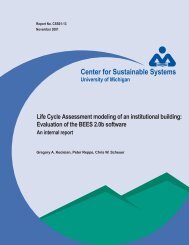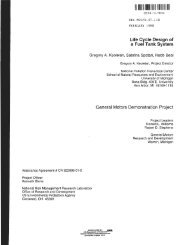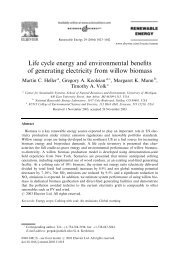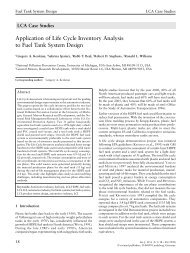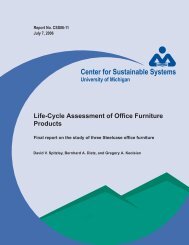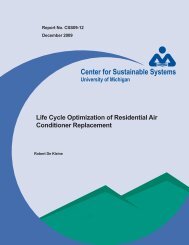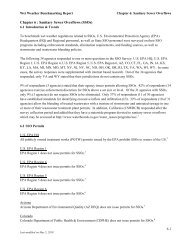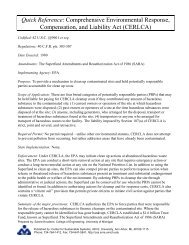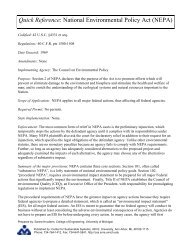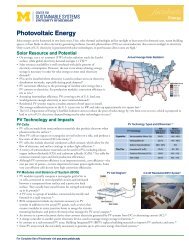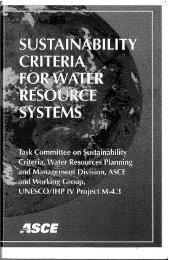A Life Cycle Assessment of the PureCell Stationary Fuel Cell System ...
A Life Cycle Assessment of the PureCell Stationary Fuel Cell System ...
A Life Cycle Assessment of the PureCell Stationary Fuel Cell System ...
- No tags were found...
You also want an ePaper? Increase the reach of your titles
YUMPU automatically turns print PDFs into web optimized ePapers that Google loves.
Chapter 3 - Goal and Scope<br />
Goal <strong>of</strong> <strong>the</strong> Study<br />
The objective <strong>of</strong> this project is to provide a guide for environmental improvement <strong>of</strong> <strong>the</strong><br />
<strong>Pure<strong>Cell</strong></strong> power system. By using LCA to model <strong>the</strong> product life cycle, <strong>the</strong> ‘hotspots’<br />
that contribute to <strong>the</strong> present environmental footprint <strong>of</strong> <strong>the</strong> product are identified. By<br />
targeting <strong>the</strong>se hotspots, opportunities for improving <strong>the</strong> environmental footprint can be<br />
explored. An analysis <strong>of</strong> <strong>the</strong> targeted hotspots is given in Chapter 5 - Impact <strong>Assessment</strong><br />
and Interpretation.<br />
Subsequent to <strong>the</strong> impact assessment results, two feasible opportunities for environmental<br />
improvement within <strong>the</strong> scope <strong>of</strong> this research were modeled in SimaPro: 1) using<br />
renewable hydrogen from wind power and 2) improving <strong>the</strong> end-<strong>of</strong>-life scenario from an<br />
environmental perspective by reusing components and maximizing platinum recycling.<br />
The goal <strong>of</strong> this part <strong>of</strong> <strong>the</strong> research is to quantify <strong>the</strong> potential environmental<br />
improvement for both opportunities relative to <strong>the</strong> current <strong>Pure<strong>Cell</strong></strong> system.<br />
Function and Functional Unit<br />
The primary function <strong>of</strong> <strong>the</strong> <strong>Pure<strong>Cell</strong></strong> system is electricity production. In addition, <strong>the</strong><br />
<strong>Pure<strong>Cell</strong></strong> system provides <strong>the</strong> option <strong>of</strong> heat recovery. The <strong>Pure<strong>Cell</strong></strong> system can thus<br />
be operated as a combined heat and power (CHP) system. The <strong>Pure<strong>Cell</strong></strong> system is used<br />
as a power supply system for remote locations where <strong>the</strong>re is no connection to <strong>the</strong><br />
electricity grid, however, it still requires that a constant supply <strong>of</strong> natural gas is available.<br />
It is also used as a source for back-up power; within this application, <strong>the</strong> <strong>Pure<strong>Cell</strong></strong><br />
system can function as a constant or as an intermittent power supply. Also, within this<br />
application <strong>the</strong> <strong>Pure<strong>Cell</strong></strong> system can function with a connection to <strong>the</strong> electricity grid as<br />
well as grid-independent. In <strong>the</strong> near future, <strong>the</strong> function <strong>of</strong> stationary fuel cells may<br />
become more significant, since <strong>the</strong>y are constant and reliable energy conversion systems<br />
and <strong>the</strong>y can <strong>the</strong>refore compensate for increased shares <strong>of</strong> fluctuating renewable energy<br />
sources used for <strong>the</strong> electricity grid.<br />
This research aims at modelling <strong>the</strong> life cycle <strong>of</strong> one <strong>Pure<strong>Cell</strong></strong> power system. The<br />
functional unit <strong>the</strong>refore is:<br />
• One <strong>Pure<strong>Cell</strong></strong> power system, generating 200 kW <strong>of</strong> electricity, 480 Volt, 60 Hz,<br />
and providing optional heat recovery <strong>of</strong> 271 kW at 60 degrees Celsius, with a<br />
lifetime <strong>of</strong> 85,000 hrs.<br />
Most <strong>of</strong> <strong>the</strong> <strong>Pure<strong>Cell</strong></strong> systems which are currently in use have a projected lifetime <strong>of</strong><br />
40,000 hrs, and this model is commonly referred to within UTC Power as <strong>the</strong> PC25 C.<br />
The PC25 C is now out <strong>of</strong> production, and it is planned to utilize a new cell stack design<br />
and a new low shift converter for <strong>the</strong> steam reforming process (toge<strong>the</strong>r with some o<strong>the</strong>r<br />
minor design changes), which will result in <strong>the</strong> PC25 D. These design changes give <strong>the</strong><br />
PC25 D an expected lifetime <strong>of</strong> 85,000 hrs. The data that are used in this LCA are based<br />
on <strong>the</strong> PC25 D system. The decision to study <strong>the</strong> PC25 D was made by UTC Power.<br />
15



